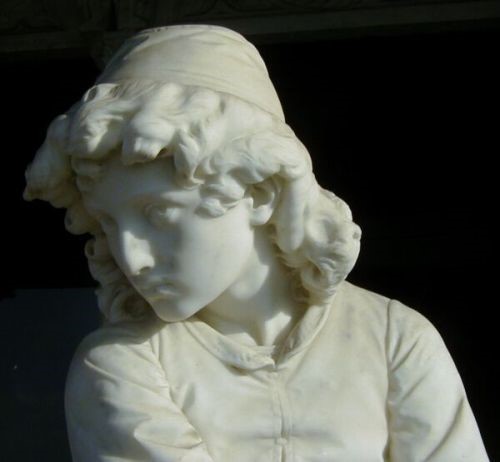"The teenager"[1] doesn't spare (himself, or herself).

"The young Columbus" by Giulio Monteverdi[2].
Monteverdi and his profitable intuition of a sculptor who digs into the success of a man and regains to chance as an adult, from the child who precedes.
Here it is then a young Christopher Columbus[3], thoughtful without sadness, and unaware – as it seems – about his own sane sensuality, autonomy and determination of thinking which make him charming, but also distancing any shadow and greed.
What is infact more distant from a psychic pathology than the capacity, all human, to start a project, which generally we call 'work', also picking up from childhood a difficult wish, but not for that less valid, to imagine it feasible at the adults age and their attractive world ?
A world made of rules, but also of 'power' which so makes it an enlarged world and universe.
Power to move, power to form alliances and to make them pay off, power to build something that as a child stopped at play.
Power to use reality with a more adequate competence, when as a child he had to ask for help the adult by whom he couldn't but depend, even if with gratitude when adults deserved.
What's more then to 'chance' of adulthood – maybe is reasoning the young Christophore Columbus by Monteverdi – who lets adolescence slip away as a too long dress, too slow, too expensive, too... ??
He is already profitably investing in studies, in disciplines, in new hugs which are no just play. 'The young Columbus' is the beauty of reality which is not eternal.
Marina Bilotta Membretti / Cernusco sul Naviglio – September 20, 2016
[1] "The teenager"(1875) is a famous novel by Fedor Dostoevski about the inability to go over the adolescence.
[2] Giulio Monteverdi, sculptor and politician (Bistagno 1837 – Roma 1917). "Il Colombo giovinetto" is a statue in marble of 1870 eand stands in the De Albertis Castle at Genoa.
[3] Cristoforo Colombo (Genova 1451 – Valladolid 1506), Italian explorer and navigator, was a sailorman since a child. Citizen of Genoa Republic, and then subject of Castiglia Realm, he grew the idea of an existing land overseas which brought him, after ups and downs and an adventurous travel, to reach the actual San Salvador on October 12, 1492.